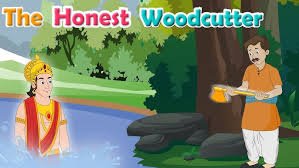The fable of The Honest Woodcutter has been cherished across generations as one of Aesop’s most impactful moral tales, though its origins may actually predate ancient Greece, with similar versions appearing in Indian, Chinese, and Middle Eastern folklore. The story begins with a poor but virtuous woodcutter who accidentally drops his prized iron axe into a deep river while working. As he despairingly mourns the loss of his essential tool – the very means of his livelihood – a mysterious water spirit or deity appears, often depicted differently across cultures as a nymph, Hermes in Greek versions, or even a talking fish in Eastern variants. Upon hearing the woodcutter’s honest account of his misfortune, the supernatural being dives into the water and resurfaces first with a gleaming golden axe. When the woodcutter truthfully states “That is not mine,” the spirit produces a silver axe, which the woodcutter again refuses, insisting on his plain iron tool. Impressed by this demonstration of integrity, the deity rewards him with all three axes – a tangible representation of how truthfulness transforms apparent loss into unexpected abundance.
What most retellings omit are the fascinating cultural nuances: in the Jataka tales (Buddhist folklore), the story features a tree deity testing the woodcutter’s character, while Persian versions include three sequential tests of honesty. The river setting holds particular symbolic weight often overlooked – in ancient symbology, water represents both the flow of destiny and the reflective surface of one’s conscience. The axe itself carries deeper meaning; in medieval allegories, it symbolized the tools of one’s trade as extensions of personal honor. Historical records suggest the fable was used in 14th century merchant guilds to teach apprentices about trade ethics, while 19th century school primers adapted it to combat industrial-era dishonesty. Modern psychologists have analyzed the woodcutter’s decision-making as a classic example of “integrity economics” – where short-term gains are sacrificed for long-term character dividends.
The characters, though simple, embody profound archetypes. The woodcutter represents the universal working class whose survival depends on both physical labor and moral fiber – his poverty making his honesty more remarkable. The water spirit serves as a supernatural mirror, reflecting back the woodcutter’s own values rather than imposing judgment. Notably absent is any villain; the conflict emerges from circumstance rather than malice, emphasizing that life tests integrity through random challenges rather than obvious moral dilemmas. Even the axes evolve symbolically – the golden one representing material temptation, the silver axe symbolizing social advancement, while the humble iron tool embodies authentic self-worth.
Beyond its surface moral about honesty, the fable explores complex themes of self-identity and value alignment. When the woodcutter rejects the golden axe, he’s not just being truthful – he’s demonstrating that his self-concept isn’t tied to external wealth. The story’s structure reveals an often-missed paradox: the woodcutter gains precisely because he shows no desire for gain. This aligns with ancient philosophical concepts like Stoicism’s “virtue is its own reward” and Eastern philosophies of non-attachment. Renaissance scholars interpreted the river as the boundary between material and spiritual worlds, where honesty becomes the bridge between realms.

The fable’s lasting impact appears in surprising places: Benjamin Franklin referenced it in Poor Richard’s Almanack to discuss colonial work ethics, while Tolstoy adapted it into a Russian peasant parable about resisting greed during land reforms. Modern ecologists have reinterpreted the tale as an allegory for sustainable resource use – the woodcutter’s care for his tool mirroring responsible environmental stewardship. In Japan, the story inspired “The Honest Woodcutter” festival in Okayama Prefecture, where children reenact the fable using prop axes to learn ethical values through play.
Contemporary neuroscience research lends credence to the fable’s core message – studies show honest decisions activate the brain’s reward centers similarly to financial gains, suggesting truthfulness provides biological fulfillment. Business schools now use the story to teach corporate social responsibility, noting how companies embracing transparency often outperform competitors long-term. The woodcutter’s choice particularly resonates in today’s digital age, where “quick wins” through deception tempt many, yet authentic personal brands ultimately thrive.
What makes this ancient story endure isn’t just its moral clarity, but its psychological realism – the woodcutter’s hesitation before refusing the golden axe (in some versions) makes his ultimate honesty more human and relatable. Unlike didactic tales where virtue feels performative, this fable acknowledges the allure of wealth while still celebrating integrity’s quiet power. The water spirit’s role as a neutral observer rather than moral authority makes the woodcutter’s choices feel genuinely voluntary, amplifying their ethical weight.
Archaeological evidence suggests the fable’s imagery may have roots in early metalworking cultures, where axes held spiritual significance as both tools and symbols of divine favor. This connects to broader mythological patterns – from Norse thunder gods wielding axes to West African folklore about forged implements containing moral energy. The story’s adaptability across eras proves its universal appeal: during the Industrial Revolution, it was repurposed to critique factory owners cutting corners, while Depression-era versions emphasized that maintaining honesty during hardship brings unexpected blessings.
Ultimately, The Honest Woodcutter survives because it speaks to humanity’s deepest questions about authenticity versus convenience. In an age of curated social media personas and get-rich-quick schemes, the woodcutter’s unpretentious truthfulness offers a countercultural model. His reward system operates differently – not through cunning or luck, but through alignment with fundamental ethical laws. The fable’s magic lies not in the supernatural intervention, but in its revelation that our greatest gains come when we remain true to who we are, even – especially – when no one is watching. As the river returns what was lost with interest to the worthy, so life has mysterious ways of honoring integrity beyond immediate calculation, making this ancient story perpetually new.
Go to main page


